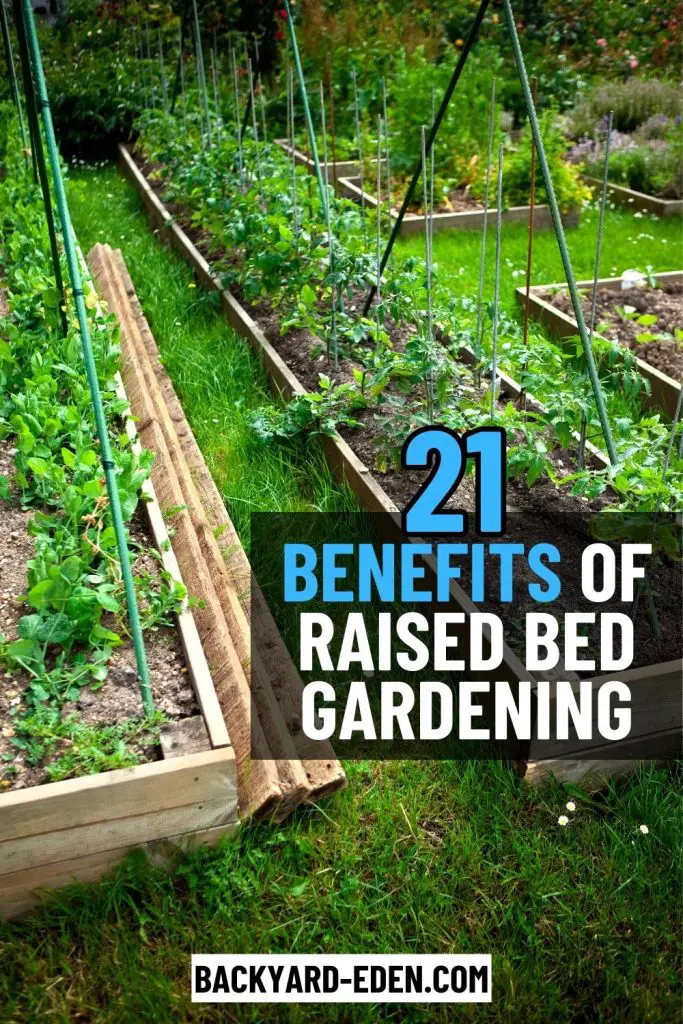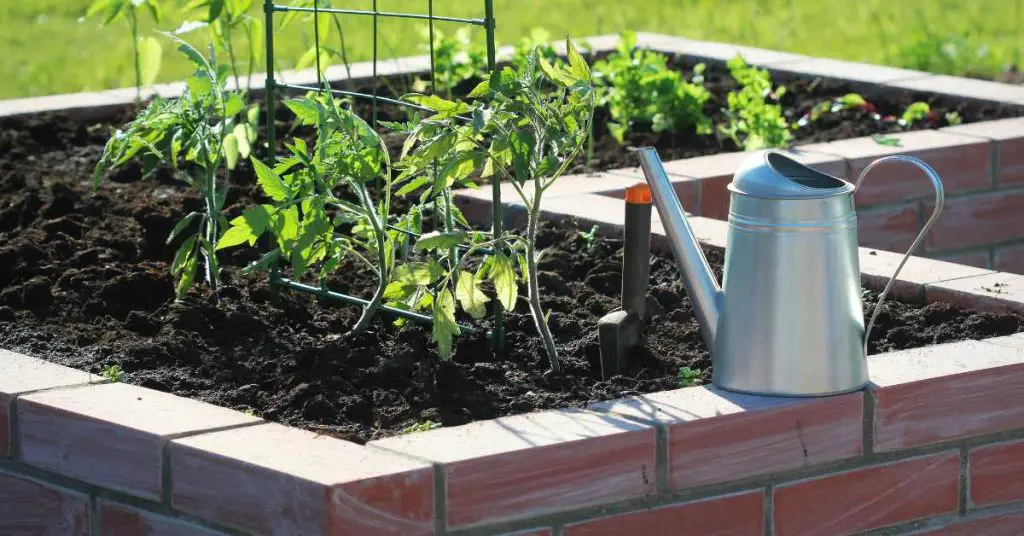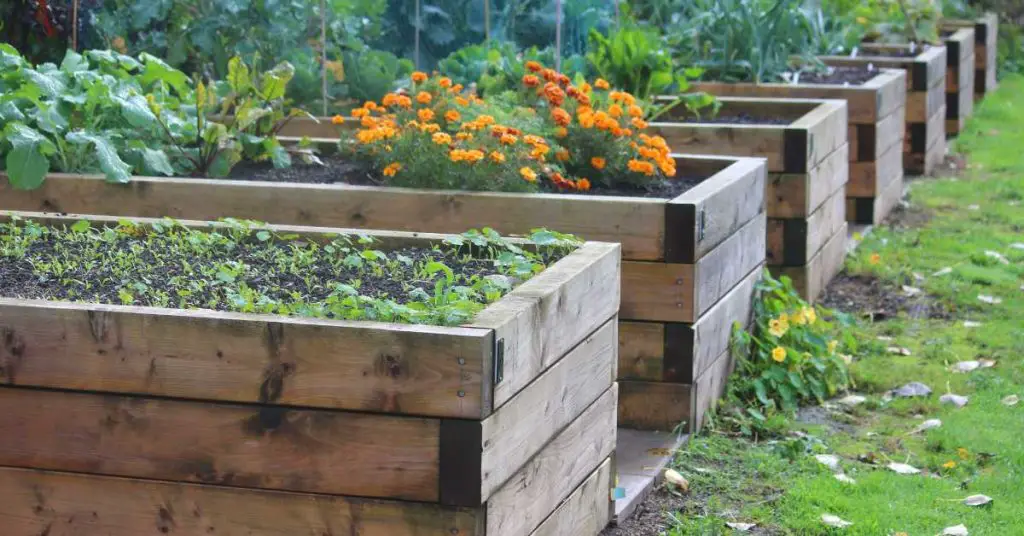Gardening has always been my sanctuary—a place where I can connect with nature and nurture beautiful plants.
But when I discovered raised bed gardening, it was like uncovering a hidden treasure trove of gardening perks.
Imagine having more control over your soil quality, fewer pest problems, and a longer growing season. It’s all possible with raised beds.
So, let’s explore these benefits in detail and find out why raised bed gardening has become a favorite among gardening enthusiasts.

What Are the Benefits of Raised Bed Gardening?
When it comes to growing a garden there are tons of benefits to using raised beds.
Improved Soil Quality
Raised bed gardening is a game-changer for soil quality. By using well-drained soil mixtures tailored to your plants’ needs, you create the perfect environment for root development. The benefits include improved fertility, aeration, and drainage, ensuring healthier plants and higher yields.
Better Pest Control
One of the most frustrating challenges for any gardener is dealing with pests. Fortunately, raised bed gardening offers better pest control. Elevated beds make it harder for ground-dwelling pests to access your plants. Plus, the confined space makes it easier to spot and manage any issues. For a more natural approach, consider companion planting and organic pest control methods.
Enhanced Drainage
Proper drainage is essential for healthy plant growth. Raised bed gardening improves drainage significantly by elevating the planting area. This means excess water won’t saturate the soil, reducing the risk of root rot and other water-related problems. Your plants will thrive in these well-drained conditions.
Extended Growing Season
Wouldn’t it be fantastic to enjoy fresh produce from your garden for a more extended period? Raised bed gardening can extend your growing season. The elevated beds warm up faster in the spring, and you can easily add protective covers to keep plants cozy in cooler weather. With the right techniques, you can harvest crops well into the fall or even winter.
Accessibility and Convenience
If you’ve ever struggled with bending or kneeling for traditional gardening, you’ll appreciate the accessibility and convenience of raised bed gardening. The elevated height reduces the need for excessive bending or stooping, making it a more comfortable option, especially for those with mobility issues. You can also design raised beds to fit your specific needs, ensuring an ergonomic gardening experience.

Weed Suppression
Dealing with weeds can be a never-ending battle. However, raised beds offer excellent weed suppression. With raised beds, it’s easier to control and prevent weeds from taking over your garden. Plus, you can use mulch or organic weed control methods to further minimize weed growth.
Space Efficiency
Raised bed gardening is a space-saver’s dream. In limited spaces, you can maximize your garden’s potential by efficiently designing raised beds. Vertical gardening, tiered beds, and creative layouts allow you to grow more in less space, making it perfect for urban and small-space gardening.
Improved Aeration
Plant roots need oxygen to thrive, and raised bed gardening promotes better aeration. The loose, well-drained soil in raised beds ensures that plant roots have access to the oxygen they need. This results in healthier, more vigorous growth.
Easy Soil Amendments
Gardeners often need to amend their soil to provide the best possible conditions for their plants. With raised beds, amending the soil is a breeze. You can easily incorporate organic matter, compost, or other soil amendments into your raised bed soil mixture, ensuring your plants get the nutrients they require.
Reduced Soil Compaction
Soil compaction can hinder root growth and water infiltration. Fortunately, raised beds prevent soil compaction because you don’t need to walk on the planting area. This means healthier roots and better overall plant growth.
Customization
Personalization is a key benefit of raised bed gardening. You can customize your raised beds to suit your gardening needs and style. Whether you prefer a traditional wooden look, a sleek modern design, or something in between, raised beds offer endless possibilities.
Better Water Management
Efficient water management is crucial for a thriving garden. Raised bed gardening improves water management by preventing excess runoff and allowing you to water precisely where needed. Drip irrigation systems and soaker hoses work exceptionally well with raised beds.

Pest Elevation
Raised beds deter certain pests because they elevate the planting surface. Common garden pests that might be discouraged by raised beds include ground-dwelling insects and rodents.
Warmer Soil Temperature
Raised beds help maintain warmer soil temperatures, especially in the early spring. This allows you to start planting earlier and extend your growing season.
Easier Harvesting
Harvesting becomes more accessible with raised bed gardening. You’ll find it easier to reach and pick your crops, reducing the physical strain on your back and knees. Consider using tools like a harvest basket or a garden apron for efficiency.
Reduced Bending and Stooping
Raised beds significantly reduce the need for bending and stooping while gardening. This is a game-changer for your comfort and back health, making gardening a more enjoyable experience.
Improved Visual Appeal
In addition to their practical benefits, raised beds can enhance the visual appeal of your garden. You can design raised beds to create stunning focal points and organized layouts that add aesthetic value to your outdoor space.
Versatility
Raised beds are incredibly versatile when it comes to plant selection. You can grow a wide variety of plants, including vegetables, herbs, flowers, and even small fruit trees, in raised beds. Their adaptability makes them suitable for various gardening styles and preferences.
Loose Soil to grow in
Raised beds promote loose and fluffy soil to grow in. The whole idea of a raised bed is that you do not step into the bed to work the soil or to put your plants in. This helps to reduce soil compaction which in turn helps the plants grow better root systems.
Sustainability
Sustainability is a significant concern for many gardeners. Raised bed gardening promotes sustainability by allowing you to use organic practices, conserve water, and minimize waste. You can create a greener and more eco-friendly garden.
Cost-Effective Gardening
While there may be some initial expenses in building raised beds, they often save money in the long run. Raised bed gardening is cost-effective because you have more control over soil quality and can extend the lifespan of your garden.

Frequently Asked Questions (FAQs)
Can I use any type of soil in raised beds?
Yes, you can use various types of soil in raised beds, but it’s essential to choose a well-draining mix tailored to your plants’ needs.
Do raised beds require a lot of maintenance?
Raised beds require relatively low maintenance compared to traditional gardens. Regular weeding and soil amendments are essential, but the reduced need for digging and tilling makes them more manageable.
What is the ideal height for raised beds?
The ideal height for raised beds depends on your comfort and mobility. However, a height of 12 to 18 inches is generally suitable for most gardeners.
Can I build raised beds on uneven ground?
Yes, you can build raised beds on uneven ground by leveling the area or using different height tiers to accommodate the slope.
Is raised bed gardening suitable for all climates?
Raised bed gardening can be adapted to various climates with the use of season extenders like row covers, cold frames, and hoop houses.
How do I protect raised beds from wildlife?
To protect your raised beds from wildlife, consider installing fencing, netting, or using deterrents like motion-activated sprinklers or noise devices.
Can I use raised beds for growing vegetables year-round?
Yes, you can use raised beds for year-round vegetable gardening with the right techniques, such as using cold frames or row covers to extend the growing season.
Are there any downsides to raised bed gardening?
While raised bed gardening offers numerous benefits, potential downsides include the initial cost of construction and the need for regular soil amendments.
What vegetables are best suited for raised beds?
Most vegetables can thrive in raised beds. However, leafy greens, root vegetables, tomatoes, and peppers are particularly well-suited for raised bed gardening.
Can raised beds be used for growing herbs and flowers?
Absolutely! Raised beds are versatile and can be used for growing a wide variety of herbs, flowers, and ornamental plants.
How do I prepare raised beds for winter?
To prepare raised beds for winter, clean out old crops, add a layer of mulch or compost, and consider covering the beds with a winter blanket or plastic sheeting.
Are there any organic pest control methods for raised beds?
Yes, there are several organic pest control methods for raised beds, including companion planting, using beneficial insects, and applying organic pest repellents.
Can I use raised beds for growing fruit trees?
While raised beds are not typically used for growing large fruit trees, they can be used for dwarf fruit trees or berry bushes that have shallow root systems.
What is the lifespan of a typical raised bed?
The lifespan of a raised bed depends on the materials used and the maintenance provided. Well-constructed raised beds can last for many years.
Can I use raised beds for organic gardening?
Yes, raised beds are well-suited for organic gardening practices. You have full control over the soil and can easily implement organic methods.
Do raised beds need a bottom layer or liner?
Raised beds do not necessarily require a bottom layer or liner. However, using landscape fabric or cardboard at the base can help prevent weeds from growing up from below.
How do I choose the right materials for building raised beds?
Select materials for raised beds based on your preferences and budget. Common options include wood, metal, concrete blocks, or recycled materials like pallets.
Are there any height recommendations for raised beds for different plants?
The ideal height of raised beds depends on your comfort and the plants you’re growing. However, most vegetables and flowers do well in beds that are 12 to 18 inches tall.
Can I use raised beds for companion planting?
Raised beds are excellent for companion planting, as you can design your planting layout to maximize the benefits of companion plants and deter pests.
What tools are essential for raised bed gardening?
Essential tools for raised bed gardening include a garden spade, hand trowel, pruners, watering can or hose, and gardening gloves.
How do I prevent soil erosion in raised beds?
To prevent soil erosion in raised beds, use mulch, cover crops, or install edging materials to keep the soil in place.
Conclusion
Raised bed gardening offers a world of benefits that can transform your gardening experience. From improved soil quality to easier accessibility and year-round gardening, there’s something for every gardener to love. So, why not take the plunge and start your own raised bed garden?
You’ll enjoy the bountiful harvests, the joy of gardening without the backache, and the countless other advantages that come with it.
Happy gardening! And if you’re hungry for more gardening knowledge, don’t hesitate to explore our other articles. Your garden will thank you.





